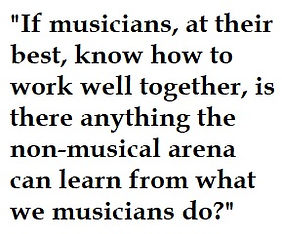
My book "Mastering Chaos: The Musician's Way" will be due out soon on Kindle and other e-Readers, Waterstones and other great book shops. On Sound Forum I will be putting it up in bite-size Episodes so this is a chance for you to get read it for free.
This forthcoming book is fundamentally about human communication and, how through the sounds we make, the influences we have on each other. It is aimed at the many, many amateur musicians out there who play music largely for a hobby, to enjoy themselves and as many of my students and friends have said, to keep themselves sane. My intention is to reveal to you that in acquiring whatever skill you have on the instrument you play you have acquired a set of ‘superpowers’ which in many ways might lie dormant within you. By bringing them to your awareness I hope to encourage you to use them for the good of yourself, your mental health and happiness but also to be able to use them to increase your success at work and if possible to enable an increasingly healthy work environment.
Let’s begin at the beginning. The very beginning. Unravelling the roots of primordial sounds and pre-language communication is fraught with difficulty. The journey from our primordial ancestors' guttural grunts to the development of language, to the intricate tapestry of music, and other arts is a fascinating chapter in human evolution. This path reveals a continuous interplay between biological adaptation, environmental pressures, and cognitive advancements, all interwoven with the ever-evolving soundscape of human communication.
While pinpointing the exact origin of spoken language remains a captivating mystery, paleoanthropological evidence suggests early hominids possessed the anatomical capacity for vocalisations as far back as 25 million years ago. These proto-humans probably relied on a repertoire of grunts, growls, and vocalisations primarily driven by emotional expression and basic survival needs. This primordial soundscape served as the foundation for further vocal development, paving the way for more nuanced communication.
Over time, social complexities and cognitive breakthroughs spurred the expansion of this communicative toolkit. Gestures, facial expressions, and even rhythmic body movements joined the vocal repertoire, forming a rich pre-language system. These multimodal interactions likely included proto-linguistic elements like shared intonations, rhythmic patterns, and vocal emphasis, laying the groundwork for the emergence of true language.
The exact timing and location of language's "invention" remain elusive. However, estimates suggest language emerged between 50,000 and 100,000 years ago, coinciding with the rise of Homo sapiens. This crucial leap involved the ability to link arbitrary symbols (words) with specific meanings (concepts). These early words might have been onomatopoeic, mimicking natural sounds, or iconic, resembling the objects they signified.
Crucially, these initial words were likely accompanied by rich vocal cues like pitch, stress, and intonation. These "proto-tonal" features served not only to differentiate words but also to convey emotional nuances and pragmatic functions, enriching communication beyond the literal meaning of spoken words.
While many modern languages have shed reliance on pitch as a grammatical tool, the influence of tonality on meaning persists in various forms. Consider languages like Mandarin, Vietnamese, and Thai, where pitch variations create distinct words even with identical consonant-vowel combinations. Even in non-tonal languages like English, subtle variations in pitch contribute to conveying sarcasm, doubt, or emphasis, demonstrating the enduring power of tonality in shaping meaning.
Furthermore, research suggests that even in non-tonal languages, listeners subconsciously pay attention to pitch variations, employing them to decode emotional cues and speaker intent. This highlights the universality of tonality as a fundamental aspect of human communication, transcending specific linguistic structures.
The journey from primordial grunts to complex languages exemplifies the remarkable evolution of human communication. Tracing this path reveals how biological adaptations, cognitive advancements, and social pressures intertwined with the changing soundscape, giving rise to the symbolic power of language. Even as some languages have moved away from explicit tonal systems, the legacy of pre-linguistic tonality lives on, subtly shaping our understanding and expression of meaning, reminding us that even in our most articulate moments, echoes of our primal past continue to resonate.
Fundamentally meaning is context dependent. When we consider the words we say and the words we hear from others, their meaning depends on the situation which surrounds the communication and at a very deep level the tonality of the way they are said.
Communication isn’t just about words. Think of a silent film and then add a variety of musical tracks. The visual experience remains exactly the same but the music changes the meaning. It can in fact change it quite drastically. It is the simple truth about tonality. Tonality changes everything.
Musicians of every kind practise. They not only focus on technical skills, they also aim to portray a message through their music. This book focuses on how this message is created and the effect the work needed to create the message has had over the lifetime of the performer...more